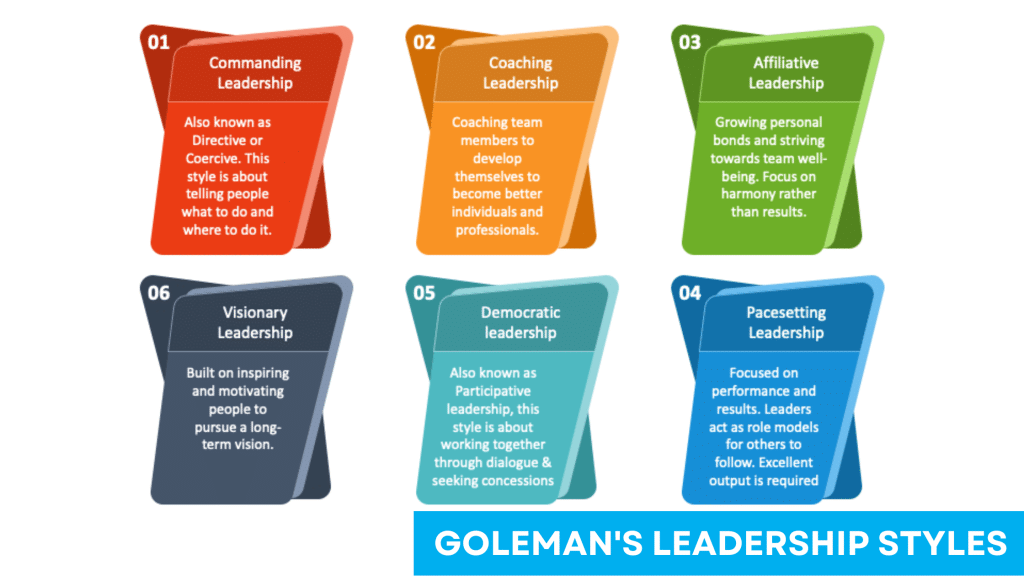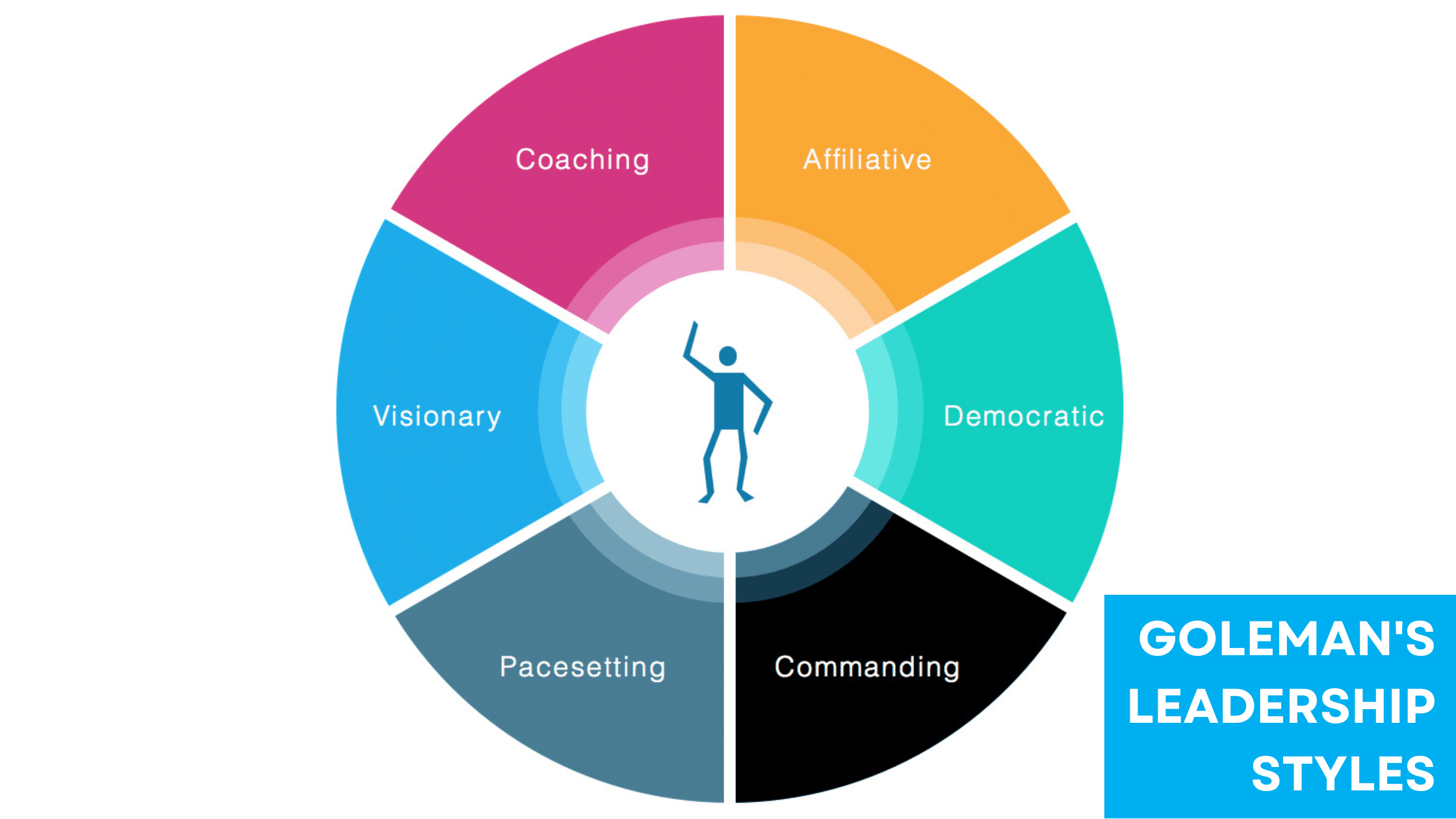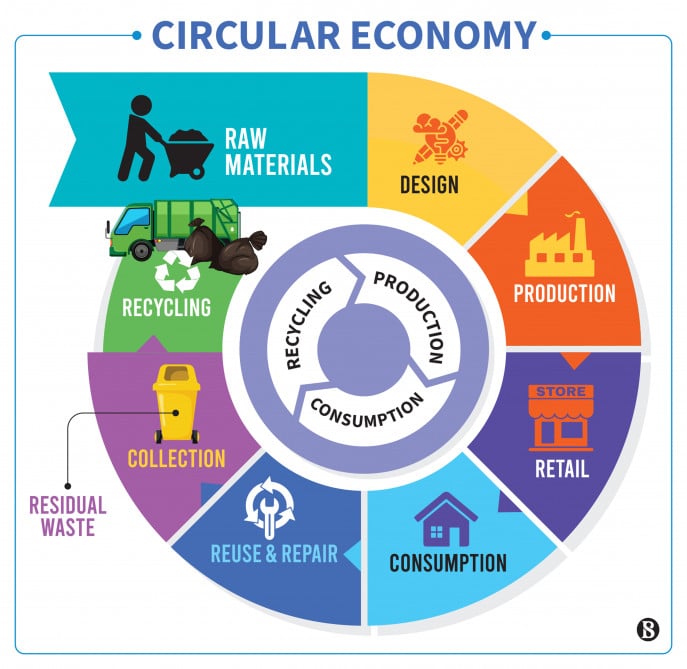Understanding Goleman’s Leadership Styles
Daniel Goleman, a well-known psychologist, studied how emotional intelligence affects leadership. He found that great leaders use different styles based on the situation.
Goleman identified six main leadership styles:
- Coercive
- Authoritative
- Affiliative
- Democratic
- Pacesetting
- Coaching
Each style has its own strengths and best uses. The coercive style gives clear orders in emergencies. The authoritative style inspires people with a vision.
The affiliative style builds strong relationships. Democratic leaders ask for input from their team. Pacesetting leaders set high standards and lead by example.
Coaching leaders help employees grow and improve. Good leaders know when to use each style. They match their approach to what their team needs.
Emotional intelligence is key to using these styles well. Leaders need to understand themselves and others. This helps them choose the right style at the right time.
Self-awareness is also essential. Leaders must know their strengths and weaknesses. This helps them use the styles that fit them best.

Emotional Intelligence as the Foundation
Emotional intelligence forms the core of effective leadership. It enables leaders to understand and manage their own emotions while skillfully navigating the feelings of others.
Self-Awareness
Self-awareness is the ability to recognize one’s emotions, strengths, and weaknesses. Leaders with high self-awareness can:
- Identify their emotional triggers
- Understand how their actions impact others
- Recognize their own biases and blind spots
This skill helps leaders make better decisions and build stronger relationships. They can adapt their behavior based on situational needs.
Emotional intelligence starts with knowing oneself. Leaders who practice self-reflection and seek feedback tend to have higher self-awareness.
Self-Management
Self-management involves controlling one’s emotions and impulses. Leaders who excel in this area can:
- Stay calm under pressure
- Adapt to change quickly
- Maintain a positive outlook
These skills allow leaders to respond thoughtfully rather than react impulsively. They can navigate challenges with grace and inspire confidence in their teams.
Effective self-management also includes setting and achieving personal and professional goals. Leaders who demonstrate this skill often have high levels of motivation and initiative.
Social Awareness
Social awareness is the ability to understand and empathize with others. Leaders with strong social awareness can:
- Read the emotional climate of a group
- Understand power dynamics in organizations
- Pick up on nonverbal cues
This skill helps leaders resolve conflicts faster and create a positive work environment. They can anticipate how their decisions will affect different stakeholders.
Empathy is a key component of social awareness. Leaders who show genuine concern for their team members build trust and loyalty.
Relationship Management
Relationship management involves using emotional intelligence to guide interactions with others. Leaders skilled in this area can:
- Communicate clearly and effectively
- Build and maintain strong networks
- Inspire and influence others
These skills enable leaders to foster collaboration and teamwork. They can manage conflicts constructively and build a positive organizational culture.
Effective relationship management also includes the ability to give and receive feedback. Leaders who excel in this area create an environment of continuous learning and growth.
The Visionary Leadership Style
Visionary leadership inspires and guides organizations toward a compelling future. This style focuses on creating a shared vision and motivating others to achieve long-term goals.
Characteristics of Visionary Leaders
Visionary leaders are forward-thinking and innovative. They have a clear picture of where they want their organization to go. These leaders communicate their vision effectively, inspiring others to join them on the journey.
Visionary leaders:
- Think big and embrace change
- Communicate clearly and passionately
- Encourage creativity and risk-taking
- Build strong, motivated teams
They excel at seeing the big picture and finding new ways to solve problems. Visionary leadership often aims to change the current way things are done.
Implementing Visionary Leadership
Leaders must first develop a clear and inspiring vision to implement visionary leadership. They need to communicate this vision regularly and enthusiastically to their team.
Key steps include:
- Crafting a compelling vision statement
- Sharing the vision through multiple channels
- Connecting daily tasks to the larger vision
- Encouraging innovation and creative thinking
Visionary leaders should also be open to feedback and willing to adapt their vision as needed. They must balance their focus on the future with attention to present-day operations and challenges.
Building a culture of trust and empowerment is crucial for this leadership style to succeed. Leaders should provide resources and support to help their team achieve the shared vision.
The Coaching Leadership Approach
The coaching leadership style focuses on developing employees’ skills and abilities. It aims to improve performance through personal growth and guidance.
Traits of Coaching Leaders
Coaching leaders are patient and supportive. They listen actively and ask thoughtful questions to help team members find solutions. These leaders give regular feedback and encourage learning from mistakes.
They set challenging goals for their employees. Coaching leaders create opportunities for growth and skill development. They believe in their team’s potential and push them to reach it.
Coaching leaders also show empathy. They try to understand each person’s strengths and weaknesses. This helps them tailor their approach to individual needs.
Developing Coaching Leadership Skills
To become a better coaching leader, practice active listening. Pay attention to both words and body language. Ask open-ended questions to encourage deeper thinking.
Provide specific, constructive feedback. Focus on actions, not personality. Offer suggestions for improvement along with praise for good work.
Learn to delegate effectively. Give employees challenging tasks that match their skills and interests. This promotes individual growth and builds trust.
Invest time in one-on-one meetings. Use these to discuss goals, progress, and obstacles. Help team members create personal development plans.
Develop your emotional intelligence. This will help you better understand and motivate your team. Practice self-awareness and empathy in your daily interactions.
The Affiliative Leadership Style
Affiliative leadership puts people first. It builds strong bonds between team members and creates a positive work environment. Leaders who use this style focus on making everyone feel valued and included.
Understanding Affiliative Leadership
Affiliative leadership is about creating harmony and emotional connections. These leaders prioritize team happiness and well-being. They believe that when people feel good, they perform better.
Affiliative leaders are empathetic and supportive. They listen to their team’s needs and concerns. This style works well during stressful times or when team morale is low.
One downside is that poor performance may go unchecked. Affiliative leaders might avoid giving tough feedback to keep the peace.
Building Affiliative Relationships
To use the affiliative style, leaders should:
- Spend time getting to know team members personally
- Celebrate team successes and milestones
- Create opportunities for social bonding
- Offer praise and positive feedback often
Building trust is key. Leaders should be open and honest with their team. They should also encourage open communication among team members.
Team-building activities can help foster connections. These might include group lunches, volunteer events, or fun team challenges.
Democratic Leadership in Practice
Democratic leadership puts teamwork and employee input at the forefront. This style boosts morale and leads to better choices through group wisdom.
Democratic Leadership Characteristics
Democratic leaders value team input and shared decision-making. They ask for ideas from all group members. This style builds trust and respect among staff.
Democratic leaders listen well. They create an open work setting where people feel free to share their thoughts. These leaders give clear info to help the team make smart choices.
They also praise good work and give helpful feedback. This helps staff grow and improve. Democratic leaders often have strong people skills.
Fostering Democratic Decision-Making
To use this style, leaders should:
- Set up regular team meetings
- Ask for input on key choices
- Use voting or consensus to decide
- Give everyone a chance to speak
- Explain final decisions to the team
Leaders can start small with this approach. They might ask for ideas on a new project or office layout. As the team gets used to it, they can tackle bigger issues.
It’s key to set ground rules. Make clear which choices need group input and which don’t. This helps avoid slow-downs on minor matters.
Pacesetting Leadership for High Productivity
Pacesetting leadership aims to boost productivity through high standards and rapid progress. This style can drive teams to achieve exceptional results in short timeframes.
Essence of Pacesetting Leadership
Pacesetting leadership focuses on setting high-performance standards. Leaders who use this style often lead by example, showing their team how to work quickly and efficiently.
They set challenging goals and expect excellence from their team members. Pacesetting leaders typically have a strong drive for achievement and push others to meet their high expectations.
This style works best with highly skilled and motivated team members. It can create a fast-paced, results-oriented environment where top performers thrive.
When to Use Pacesetting Style
Pacesetting leadership is most effective in specific situations:
- During crises or urgent projects requiring quick results
- With highly skilled teams that need a little direction
- For short-term productivity boosts
It’s important to use this style sparingly. Overuse can lead to burnout and decreased morale among team members.
Coercive Leadership: Command and Control
Coercive leadership involves a top-down approach where leaders give direct orders and expect immediate compliance. This style relies on strict control and can be useful in crisis situations but may harm team morale if overused.
Identifying Coercive Leadership
Coercive leaders often use a command-and-control approach. They make decisions without input from others and expect quick obedience. These leaders might say things like “Do it because I said so” or “Follow my instructions exactly.”
Key traits of coercive leaders include:
- Giving direct orders
- Threatening punishment for non-compliance
- Closely monitoring employee actions
- Rarely asking for input or feedback
This style can create a tense work environment. Team members may feel their ideas aren’t valued. Coercive leaders focus on short-term results over long-term growth.
Appropriate Contexts for Coercive Leadership
While often seen as negative, coercive leadership can be effective in certain situations.
It works best in true emergencies or when quick, decisive action is needed.
Scenarios where coercive leadership may be useful:
- Natural disasters or crises
- Military operations
- Corporate turnarounds
- Dealing with problem employees
In these cases, a commanding leader can provide clear direction.
This can help teams act quickly and decisively. However, leaders should use this style sparingly.
Overuse can damage team morale and reduce creativity.
Effective coercive leaders know when to switch to more collaborative styles once the crisis passes.
They balance firm direction with respect for their team members.
Creating a Positive Workplace Environment
Leadership plays a crucial role in shaping workplace culture and boosting team morale.
Effective leaders use specific strategies to create an environment where employees feel valued and motivated.
Role of Leadership in Culture Building
Leaders set the tone for company culture through their actions and decisions.
They shape the workplace environment by modeling desired behaviors and values.
Leaders who prioritize open communication foster trust among team members.
Consistent feedback and recognition help employees feel appreciated.
Leaders can organize team-building activities to strengthen relationships. They should also address conflicts promptly and fairly to maintain a positive atmosphere.
Encouraging innovation and risk-taking shows employees their ideas are valued.
Leaders who promote work-life balance demonstrate care for their team’s well-being.
Strategies for Enhancing Team Morale
Regular check-ins allow leaders to gauge employee satisfaction and address concerns.
Offering professional development opportunities shows investment in staff growth.
Celebrating team and individual achievements boosts morale and motivation.
Creating a comfortable physical workspace can improve mood and productivity.
Flexible work arrangements, when possible, can reduce stress and increase job satisfaction.
Organizing social events helps build camaraderie outside of work tasks.
Clear communication of company goals helps employees understand their role in the bigger picture.
Involving team members in decision-making processes increases engagement and ownership.
Providing the necessary tools and resources for success empowers employees to perform their best.
Leadership Impact on Employee Engagement
Leaders shape workplace culture and influence employee attitudes. Their approach affects how connected and motivated staff feel at work.
Boosting Job Satisfaction through Leadership
Goleman leadership styles can boost job satisfaction.
Democratic leaders ask for input, making employees feel valued. Coaching leaders help staff grow, increasing fulfillment.
Affiliative leaders build strong bonds. They create a positive work environment where people feel supported. This leads to higher job satisfaction.
Visionary leaders inspire teams with clear goals. Employees understand their purpose and feel more satisfied in their roles.
Leaders who use a mix of styles can address different needs.
They adapt to boost morale and create a more engaging workplace.
Reducing Turnover with Effective Leaders
Good leadership directly impacts employee retention.
When leaders communicate well and show appreciation, staff are more likely to stay.
Effective leaders create growth opportunities.
They help employees develop skills and advance their careers. This reduces the desire to look for jobs elsewhere.
Leaders who listen to concerns and act on feedback build trust.
Employees feel heard and respected, decreasing turnover rates.
Fair treatment and recognition from leaders matter.
When staff feel valued, they’re less likely to leave. This saves companies money on hiring and training.
The Situational Leadership Perspective
Situational leadership adapts to team needs and contexts. It requires leaders to assess situations and adjust their approach for best results.
Adapting to Team Dynamics
Leaders must read team dynamics and adjust their style.
This means watching how team members interact and work together.
A leader might use a commanding style with a new team that needs clear direction. For a skilled team, a democratic style could work better.
Team maturity affects leadership choices.
New teams often need more guidance. Experienced teams may thrive with less direct leadership.
Leaders should check team progress and morale often. This helps them know when to step in or step back.
Cultural factors also shape team dynamics.
Leaders must respect diverse backgrounds and work styles. They should create an environment where all team members feel valued and heard.
Situational Leadership Skills
Situational leaders need sharp observation skills.
They must quickly spot what their team needs. This includes noticing both verbal and non-verbal cues from team members.
Flexibility is key.
Leaders should be ready to switch styles as needed.
They might use a coaching style one day and a pacesetting style the next. The goal is to match the style to the situation.
Communication skills are crucial.
Leaders must clearly explain their decisions and expectations. They should also listen to team feedback and concerns.
Emotional intelligence helps leaders connect with their team.
This skill lets them understand and manage emotions in themselves and others.
It’s vital for building trust and motivating teams.
Leadership Development and Career Growth
Leadership skills can be learned and improved over time. Good leadership often involves using different styles for different situations.
Leaders should focus on personal development to enhance their abilities.
This includes learning new skills, seeking feedback, and reflecting on experiences.
Career growth in leadership roles requires continuous learning and adaptation.
Leaders must stay current with industry trends and best practices.
Employee satisfaction is closely tied to leadership quality.
Effective leaders create positive work environments and motivate their teams.
Some key areas for leadership development include:
- Communication skills
- Decision-making abilities
- Emotional intelligence
- Strategic thinking
- Conflict resolution
Leadership approaches can vary based on the situation and team needs.
Leaders should be flexible and adapt their style as needed.
Organizations often offer leadership training programs to develop talent internally.
These programs can help employees grow into leadership roles over time.
Mentorship plays a crucial role in leadership development.
Experienced leaders can guide and support emerging leaders in their career journeys.
Self-awareness is essential for leadership growth.
Leaders should regularly assess their strengths and areas for improvement.
Conclusion
Leaders can greatly benefit from understanding and applying Goleman’s six leadership styles. These styles offer a range of approaches to guide and motivate teams effectively.
Knowing when to use each style is key.
The commanding style works well in crises, while the democratic style shines during collaborative projects.
Flexibility is crucial. Great leaders adapt their style to fit different situations and team members’ needs.
Developing emotional intelligence helps leaders choose the right style at the right time. This skill allows them to read team dynamics and respond appropriately.
Practice and self-reflection are essential for mastering these styles.
Leaders should seek feedback and continuously work on improving their leadership skills.
Mastering Goleman’s leadership styles can create more engaged, productive, and satisfied teams. This leads to better outcomes for both individuals and organizations.
The six leadership styles provide a valuable framework for effective leadership.
With practice and awareness, leaders can use these tools to drive success and foster positive work environments.



